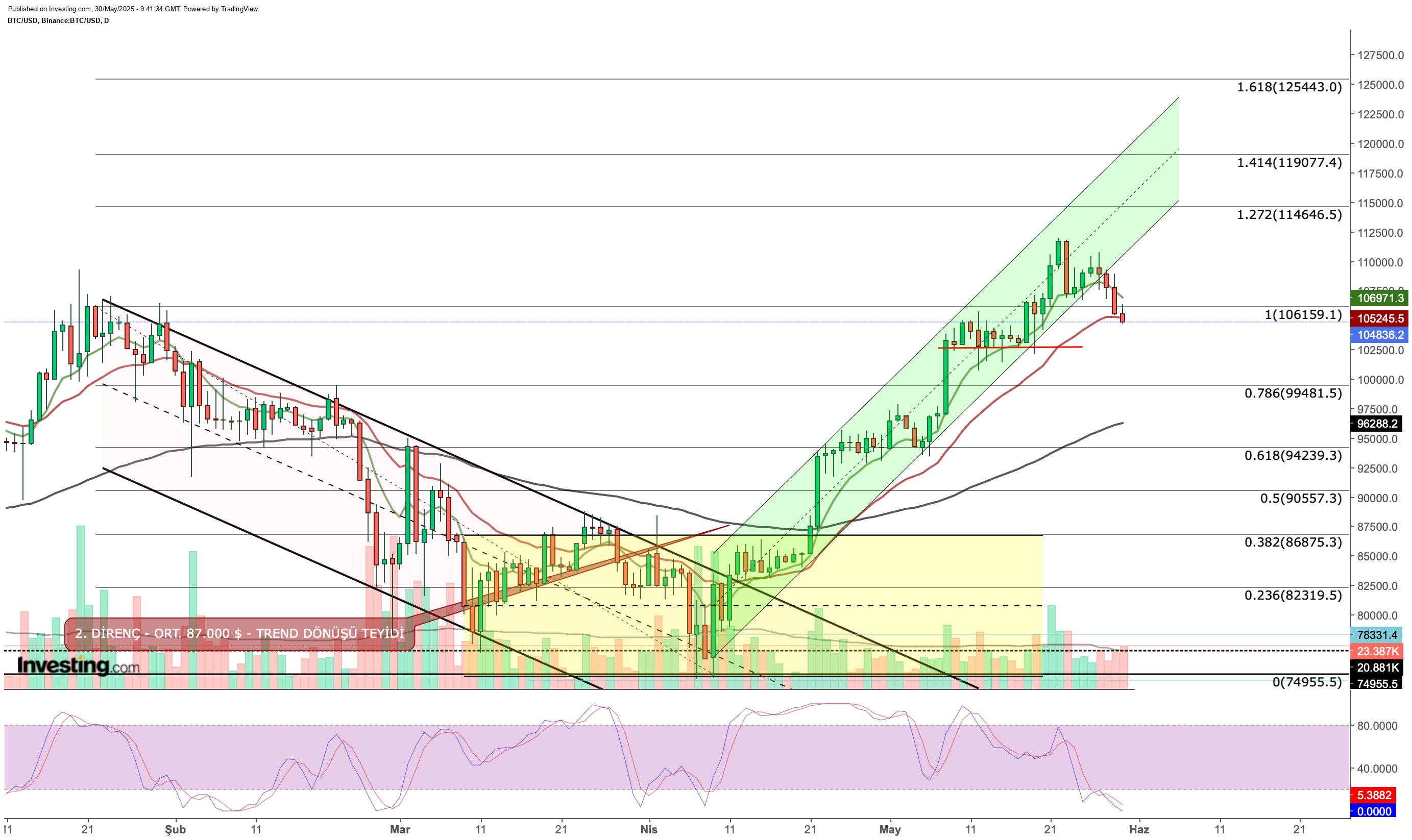Nvidia shares pop as analysts dismiss AI bubble concerns
- Bitcoin’s May rally showed strong momentum but faced pressure from late-month profit-taking.
- On-chain data signals long-term accumulation and sustained institutional confidence despite short-term volatility.
- Key drivers ahead: ETF flows, macro shifts, and reactions at $105K–$108K technical levels.
- Looking for actionable trade ideas to navigate the current market volatility? Subscribe here to unlock access to InvestingPro’s AI-selected stock winners.
Bitcoin delivered a strong performance in May, climbing nearly 20% to a new all-time high of $111,954. However, late-month selling pressure trimmed those gains, bringing the monthly advance down to around 10%. Still, the recent rally reflected solid momentum across both technical and fundamental indicators. As June begins, investors are watching closely for signs of another potential bullish leg.
On-Chain Data Confirms Long-Term Confidence
On-chain data suggests that Bitcoin’s May rally was driven not only by speculative demand but also by rising confidence from both institutional and retail investors. Nearly 66,975 BTC—worth around $7.2 billion—were withdrawn from exchanges to private wallets during the month. This trend signals ongoing accumulation and a strong belief in Bitcoin’s long-term upside.
Throughout May, this accumulation helped sustain a broadly positive outlook, with occasional price surges triggered by FOMO-driven buying. At the same time, the growing share of long-term holders contributed to reduced selling pressure—further supporting Bitcoin’s steady upward trend.
Macroeconomic Trends Favor Uptrend
On the macroeconomic front, several factors continue to support Bitcoin’s upward trajectory. Easing global inflation has given central banks more flexibility to shift toward looser monetary policy. Meanwhile, a weakening US Dollar and falling real interest rates have boosted investor appetite for risk assets like Bitcoin.
Bitcoin’s growing correlation with equity markets and steady institutional inflows suggest that it is becoming increasingly integrated into the traditional financial system. This highlights a broader shift: Bitcoin is now being influenced more by global macroeconomic trends than by crypto-specific developments.
Key issues shaping Bitcoin’s recent price action include the US stance on tariffs and Federal Reserve policy. The US Federal Trade Court’s initial decision to block tariffs provided brief relief to markets. However, that optimism faded quickly when an appeals court halted the cancellation, reigniting uncertainty. As this chaotic environment around trade policy resurfaced, Bitcoin’s recent pullback gained momentum.
Today, markets await the release of the Personal Consumption Expenditures (PCE) index, the Fed’s preferred gauge of inflation. A softer-than-expected reading could ease concerns about inflation and strengthen expectations of a more dovish stance from the Fed—potentially providing indirect support for Bitcoin.
Meanwhile, Spot Bitcoin ETFs, which saw robust inflows throughout May, experienced net outflows toward the end of the month. This points to short-term investors locking in profits amid market uncertainty. However, the broader trend remains strong. Total (EPA:TTEF) inflows remain near $45 billion, underscoring continued institutional interest and a resilient medium-term outlook for Bitcoin.
Investors Cautious Despite Upward Trend
Bitcoin currently holds strong potential to extend its uptrend, supported by favorable macroeconomic conditions, robust demand, and sustained accumulation by long-term holders. However, in the short term, the market remains sensitive to pullbacks triggered by profit-taking.
As we move into June, price action around key technical levels will be crucial to watch. ETF flows, continued accumulation trends, and macroeconomic signals remain the primary drivers influencing Bitcoin’s trajectory.
Technical Outlook in Bitcoin

Although Bitcoin made another push toward the $110,000 mark earlier this week, profit-taking intensified following the sharp retreat on May 23.
Midweek, the cryptocurrency lost support at $108,000, breaking below the uptrend that began in April. The lower boundary of the ascending channel also aligned with the 8-day Exponential Moving Average (EMA), which had served as dynamic support in the short term. By the end of the week, Bitcoin is testing intermediate support at the 21-day EMA, currently around $105,300.
Holding this level on daily closes could help contain the current pullback. However, reclaiming the $108,000 zone is critical for resuming the uptrend. A successful breakout could restore bullish momentum and open the door to the next target range between $114,000 and $125,000.
On the downside, a break below $105,000 could trigger a move toward the early-May support zone near $102,500. If bearish momentum continues, the psychologically significant $100,000 level will be the next key support to watch.
Despite short-term volatility, Bitcoin’s medium- and long-term outlook remains constructive. Any corrective moves may simply broaden the current uptrend channel and provide new entry points for long-term investors.
****
Whether you’re a novice investor or a seasoned trader, leveraging InvestingPro can unlock a world of investment opportunities while minimizing risks amid the challenging market backdrop.
Subscribe now and instantly unlock access to several market-beating features, including:
- ProPicks AI: AI-selected stock winners with a proven track record.
- InvestingPro Fair Value: Instantly find out if a stock is underpriced or overvalued.
- Advanced Stock Screener: Search for the best stocks based on hundreds of selected filters and criteria.
- Top Ideas: See what stocks billionaire investors such as Warren Buffett, Michael Burry, and George Soros are buying.

Disclaimer: This article is written for informational purposes only. It is not intended to encourage the purchase of assets in any way, nor does it constitute a solicitation, offer, recommendation or suggestion to invest. I would like to remind you that all assets are evaluated from multiple perspectives and are highly risky, so any investment decision and the associated risk rests with the investor. We also do not provide any investment advisory services.
